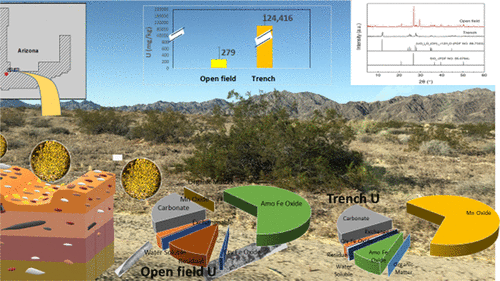当前位置:
X-MOL 学术
›
ACS Earth Space Chem.
›
论文详情
Our official English website, www.x-mol.net, welcomes your
feedback! (Note: you will need to create a separate account there.)
Distribution and Fractionation of Uranium in Weapon Tested Range Soils
ACS Earth and Space Chemistry ( IF 2.9 ) Pub Date : 2021-01-20 , DOI: 10.1021/acsearthspacechem.0c00326 Joseph A Kazery 1 , Georgio Proctor 2 , Steve L Larson 3 , John H Ballard 3 , Heather M Knotek-Smith 3 , Qinku Zhang 2 , Ahmet Celik 2 , Shaloam Dasari 1 , Saiful M Islam 2 , Paul B Tchounwou 1 , Fengxiang X Han 2
ACS Earth and Space Chemistry ( IF 2.9 ) Pub Date : 2021-01-20 , DOI: 10.1021/acsearthspacechem.0c00326 Joseph A Kazery 1 , Georgio Proctor 2 , Steve L Larson 3 , John H Ballard 3 , Heather M Knotek-Smith 3 , Qinku Zhang 2 , Ahmet Celik 2 , Shaloam Dasari 1 , Saiful M Islam 2 , Paul B Tchounwou 1 , Fengxiang X Han 2
Affiliation

|
Uranium is a chemically toxic and radioactive heavy metal. Depleted uranium (DU) is the byproduct of the uranium enrichment process, with a majority of U as uranium-238, and a lower content of the fissile isotope uranium-235 than natural uranium. Uranium-235 is mainly used in nuclear reactors and in the manufacture of nuclear weapons. Exposure is likely to have an impact on humans or the ecosystem where military operations have used DU. Yuma Proving Ground in Arizona, USA has been using depleted uranium ballistics for 36 years. At a contaminated site in the Proving Grounds, soil samples were collected from the flat, open field and lower elevated trenches that typically collect summer runoff. Spatial distribution and fractionation of uranium in the fields were analyzed with total acid digestion and selective sequential dissolution with eight operationally defined solid-phase fractions. In addition to uranium, other trace elements (As, Ba, Co, Cr, Cu, Hg, Mo, Nb, Pd, Pb, V, Zn, Zr) were also assessed. Results show that the trench area in the testing site had a higher accumulation of total U (12.4%) compared to the open-field soil with 279 mg/kg U. Among the eight solid-phase components in the open-field samples, U demonstrated stronger affinities for the amorphous iron-oxide bound, followed by the carbonate bound, and the residual fractions. However, U in the trench area had a stronger binding to the easily reducible oxide bound fraction, followed by the carbonate-bound and amorphous iron-oxide-bound fractions. Among other trace elements, Nb, As, and Zr exhibited the strongest correlations with U distribution among solid-phase components. This study indicates a significant spatial variation of U distribution in the shooting range site. Fe/Mn oxides and carbonate were the major solid-phase components for binding U in the weapon test site.
中文翻译:

武器试验场土壤中铀的分布和分馏
铀是一种具有化学毒性和放射性的重金属。贫铀(DU)是铀浓缩过程的副产品,其中大部分铀为铀238,裂变同位素铀235的含量低于天然铀。铀235主要用于核反应堆和核武器的制造。接触可能会对人类或军事行动使用贫化铀的生态系统产生影响。美国亚利桑那州尤马试验场使用贫铀弹道技术已有 36 年历史。在试验场的一个受污染地点,从平坦的开阔场地和通常收集夏季径流的较低高架沟渠中采集了土壤样本。通过总酸消解和八种可操作定义的固相馏分的选择性顺序溶解,分析了油田中铀的空间分布和分馏。除铀外,还评估了其他微量元素(As、Ba、Co、Cr、Cu、Hg、Mo、Nb、Pd、Pb、V、Zn、Zr)。结果表明,与露地土壤相比,试验场地沟渠区域的总U积累量较高(12.4%),U含量为279 mg/kg。在露地样品的8种固相成分中,U表现出对无定形氧化铁结合的更强的亲和力,其次是碳酸盐结合和残余部分。然而,沟槽区域中的 U 与易还原氧化物结合部分的结合较强,其次是碳酸盐结合部分和非晶态氧化铁结合部分。在其他微量元素中,Nb、As和Zr与固相组分中的U分布表现出最强的相关性。这项研究表明射击场场地 U 分布存在显着的空间变化。 Fe/Mn氧化物和碳酸盐是武器试验场中结合U的主要固相成分。
更新日期:2021-02-18
中文翻译:

武器试验场土壤中铀的分布和分馏
铀是一种具有化学毒性和放射性的重金属。贫铀(DU)是铀浓缩过程的副产品,其中大部分铀为铀238,裂变同位素铀235的含量低于天然铀。铀235主要用于核反应堆和核武器的制造。接触可能会对人类或军事行动使用贫化铀的生态系统产生影响。美国亚利桑那州尤马试验场使用贫铀弹道技术已有 36 年历史。在试验场的一个受污染地点,从平坦的开阔场地和通常收集夏季径流的较低高架沟渠中采集了土壤样本。通过总酸消解和八种可操作定义的固相馏分的选择性顺序溶解,分析了油田中铀的空间分布和分馏。除铀外,还评估了其他微量元素(As、Ba、Co、Cr、Cu、Hg、Mo、Nb、Pd、Pb、V、Zn、Zr)。结果表明,与露地土壤相比,试验场地沟渠区域的总U积累量较高(12.4%),U含量为279 mg/kg。在露地样品的8种固相成分中,U表现出对无定形氧化铁结合的更强的亲和力,其次是碳酸盐结合和残余部分。然而,沟槽区域中的 U 与易还原氧化物结合部分的结合较强,其次是碳酸盐结合部分和非晶态氧化铁结合部分。在其他微量元素中,Nb、As和Zr与固相组分中的U分布表现出最强的相关性。这项研究表明射击场场地 U 分布存在显着的空间变化。 Fe/Mn氧化物和碳酸盐是武器试验场中结合U的主要固相成分。











































 京公网安备 11010802027423号
京公网安备 11010802027423号